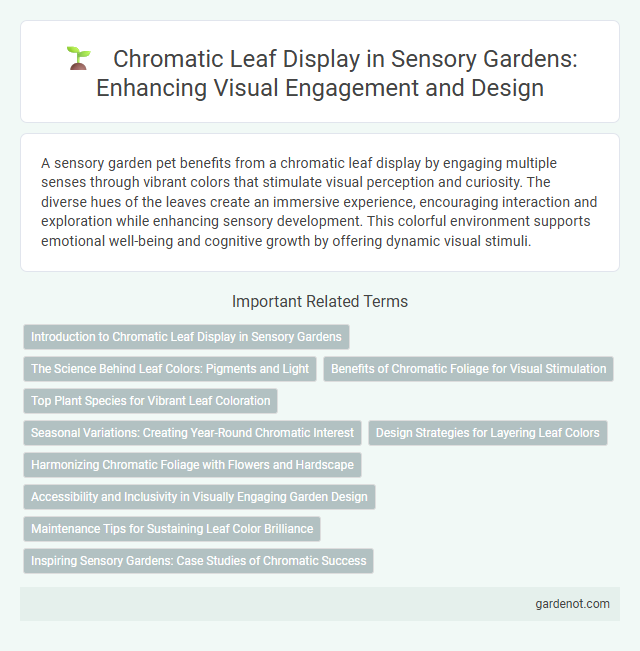A sensory garden pet benefits from a chromatic leaf display by engaging multiple senses through vibrant colors that stimulate visual perception and curiosity. The diverse hues of the leaves create an immersive experience, encouraging interaction and exploration while enhancing sensory development. This colorful environment supports emotional well-being and cognitive growth by offering dynamic visual stimuli.
Introduction to Chromatic Leaf Display in Sensory Gardens
Chromatic leaf displays in sensory gardens showcase a vibrant variety of foliage colors that stimulate visual senses and enhance garden aesthetics. These displays often include plants with leaves in hues of red, purple, yellow, and variegated patterns, promoting engagement and relaxation for visitors. Integrating chromatic leaves supports biodiversity while creating a dynamic sensory experience that evolves with seasonal changes.
The Science Behind Leaf Colors: Pigments and Light
Chromatic leaf displays result from the interaction of pigments such as chlorophyll, carotenoids, and anthocyanins with light wavelengths. Chlorophyll absorbs blue and red light for photosynthesis, giving leaves their green color, while carotenoids reflect yellow and orange hues. Anthocyanins produce red and purple colors by absorbing green light, creating vibrant contrasts in sensory garden foliage throughout seasonal changes.
Benefits of Chromatic Foliage for Visual Stimulation
Chromatic leaf displays in sensory gardens offer vibrant color variations that enhance visual stimulation and cognitive engagement. The diverse hues of foliage, ranging from deep purples to bright reds and yellows, create dynamic patterns that promote sensory exploration and mental relaxation. This natural color contrast supports neurological benefits by aiding focus and reducing stress through immersive visual experiences.
Top Plant Species for Vibrant Leaf Coloration
Maple trees (Acer spp.) exhibit striking red and orange hues, making them ideal for chromatic leaf displays in sensory gardens. Japanese maple (Acer palmatum) offers a variety of leaf shapes and vibrant red, purple, and orange colors, enhancing seasonal visual interest. Ornamental smoke bush (Cotinus coggygria) contributes deep burgundy and pink foliage, creating dynamic color contrasts within plant compositions.
Seasonal Variations: Creating Year-Round Chromatic Interest
Chromatic leaf displays in sensory gardens showcase vibrant seasonal variations by featuring plant species with foliage that changes color throughout the year, such as maples, dogwoods, and smokebushes. These plants provide year-round chromatic interest by transitioning through shades of green, red, orange, and purple, enhancing visual stimulation in every season. Strategic selection of deciduous and evergreen species ensures continuous sensory engagement with evolving textures and hues.
Design Strategies for Layering Leaf Colors
Layering leaf colors in a sensory garden enhances visual interest by combining contrasting hues such as deep purples, vibrant yellows, and rich greens to create dynamic chromatic displays. Strategic placement of foliage with varying textures and tones, like variegated hostas alongside bold coleus, amplifies depth and seasonal appeal. Incorporating plants with changing leaf colors, such as Japanese maples and smoke bushes, ensures continuous color evolution throughout the growing season.
Harmonizing Chromatic Foliage with Flowers and Hardscape
Chromatic leaf displays create vibrant focal points by integrating foliage with varying hues, from deep purples to bright chartreuses, enhancing sensory garden aesthetics. Harmonizing these colorful leaves alongside complementary flower colors, such as soft pastels or bold primary shades, amplifies visual depth and seasonal interest. Incorporating hardscape elements like natural stone paths or wooden benches in neutral tones provides balance, allowing the chromatic foliage to stand out without overwhelming the garden's sensory experience.
Accessibility and Inclusivity in Visually Engaging Garden Design
Chromatic leaf displays in sensory gardens enhance accessibility by incorporating high-contrast foliage colors that aid individuals with visual impairments in distinguishing plant varieties easily. Using a diverse palette of reds, yellows, and purples alongside tactile markers supports inclusivity, ensuring multi-sensory engagement for all visitors. Strategic placement of brightly colored leaves combined with textured signage fosters an immersive, navigable garden experience catering to diverse sensory needs.
Maintenance Tips for Sustaining Leaf Color Brilliance
To sustain the vibrant chromatic leaf display in a sensory garden, ensure consistent watering schedules that prevent both drought stress and overwatering, which can dull leaf colors. Regular pruning removes dead or faded foliage, promoting new growth with brighter pigmentation. Using slow-release fertilizers rich in potassium enhances chlorophyll production, maintaining strong and vivid leaf coloration throughout the seasons.
Inspiring Sensory Gardens: Case Studies of Chromatic Success
Chromatic leaf displays in sensory gardens create visually stimulating environments that enhance emotional and cognitive responses. Case studies reveal that selecting plant species with diverse foliage colors, such as Maples (Acer spp.) and Heuchera varieties, successfully fosters continuous seasonal interest and sensory engagement. Integrating chromatic foliage with tactile and aromatic elements elevates sensory garden design, supporting therapeutic and educational outcomes.
Chromatic leaf display Infographic

 gardenot.com
gardenot.com